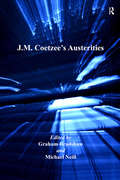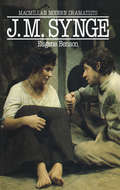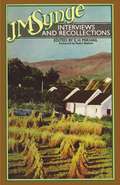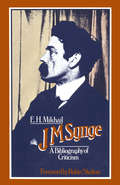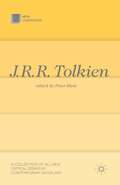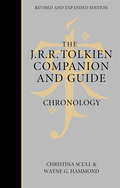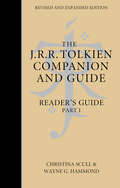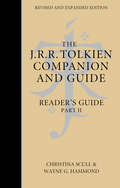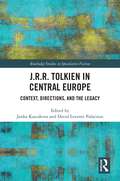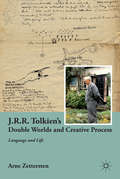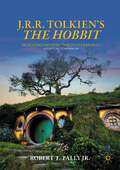- Table View
- List View
J.M. Coetzee's Austerities
by Graham Bradshaw Michael NeillRepresenting a wide range of critical and theoretical perspectives, this volume examines J.M. Coetzee's novels from Dusklands to Diary of a Bad Year. The choice of essays reflects three broad goals: aligning the South African dimension of Coetzee's writing with his "late modernist" aesthetic; exploring the relationship between Coetzee's novels and his essays on linguistics; and paying particular attention to his more recent fictional experiments. These objectives are realized in essays focusing on, among other matters, the function of names and etymology in Coetzee's fiction, the vexed relationship between art and politics in apartheid South Africa, the importance of film in Coetzee's literary sensibility, Coetzee's reworkings of Defoe, the paradoxes inherent in confessional narratives, ethics and the controversial politics of reading Disgrace, intertextuality and the fictional self-consciousness of Slow Man. Through its pronounced emphasis on the novelist's later work, the collection points towards a narrato-political and linguistic reassessment of the Coetzee canon.
J. M. Coetzee’s The Childhood of Jesus: The Ethics of Ideas and Things
by Anthony Uhlmann Jennifer RutherfordSince the controversy and acclaim that surrounded the publication of Disgrace (1999), the awarding of the Nobel Prize for literature and the publication of Elizabeth Costello: Eight Lessons (both in 2003), J. M. Coetzee's status has begun to steadily rise to the point where he has now outgrown the specialized domain of South African literature. Today he is recognized more simply as one of the most important writers in the English language from the late 20th and early 21st century. Coetzee's productivity and invention has not slowed with old age. The Childhood of Jesus, published in 2013, like Elizabeth Costello, was met with a puzzled reception, as critics struggled to come to terms with its odd setting and structure, its seemingly flat tone, and the strange affectless interactions of its characters. Most puzzling was the central character, David, linked by the title to an idea of Jesus. J.M. Coetzee's The Childhood of Jesus: The Ethics of Ideas and Things is at the forefront of an exciting process of critical engagement with this novel, which has begun to uncover its rich dialogue with philosophy, theology, mathematics, politics, and questions of meaning.
J. M. Coetzee’s The Childhood of Jesus: The Ethics of Ideas and Things
by Anthony Uhlmann Jennifer RutherfordSince the controversy and acclaim that surrounded the publication of Disgrace (1999), the awarding of the Nobel Prize for literature and the publication of Elizabeth Costello: Eight Lessons (both in 2003), J. M. Coetzee's status has begun to steadily rise to the point where he has now outgrown the specialized domain of South African literature. Today he is recognized more simply as one of the most important writers in the English language from the late 20th and early 21st century. Coetzee's productivity and invention has not slowed with old age. The Childhood of Jesus, published in 2013, like Elizabeth Costello, was met with a puzzled reception, as critics struggled to come to terms with its odd setting and structure, its seemingly flat tone, and the strange affectless interactions of its characters. Most puzzling was the central character, David, linked by the title to an idea of Jesus. J.M. Coetzee's The Childhood of Jesus: The Ethics of Ideas and Things is at the forefront of an exciting process of critical engagement with this novel, which has begun to uncover its rich dialogue with philosophy, theology, mathematics, politics, and questions of meaning.
J. M. Coetzee's Poetics of the Child: Arendt, Agamben, and the (Ir)responsibilities of Literary Creation
by Charlotta ElmgrenTracing how central tensions in J.M. Coetzee's fiction converge in and are made visible by the child figure, this book establishes the centrality of the child to Coetzee's poetics. Through readings of novels from Dusklands to The Schooldays of Jesus, Charlotta Elmgren shows how Coetzee's writing stages the constant interplay between irresponsibility and responsibility-to the self, the other, and the world. In articulating this poetics of (ir)responsibility, Elmgren offers the first sustained engagement with the intersections between Coetzee's work and the philosophical thought of Giorgio Agamben. With reference also to Hannah Arendt's thinking on natality, education, and amor mundi, Elmgren demonstrates the inextricable links in Coetzee's writing between freedom, play, and serious attention to the world. The book identifies five central dynamics of Coetzee's poetics: the child as a figure of truth-telling and authenticity; the ethics of the not-so-other child; the child, new beginnings and care for the world; childish behaviour as perpetual study; and the redemptive potential of infancy. Offering a fresh contribution to the field of literary childhood studies, Elmgren shows the critical possibilities in thinking about-and with-childlike openness and childish experimentation when approaching the writing and reading of the work of J.M. Coetzee and beyond.
J. M. Coetzee's Poetics of the Child: Arendt, Agamben, and the (Ir)responsibilities of Literary Creation
by Charlotta ElmgrenTracing how central tensions in J.M. Coetzee's fiction converge in and are made visible by the child figure, this book establishes the centrality of the child to Coetzee's poetics. Through readings of novels from Dusklands to The Schooldays of Jesus, Charlotta Elmgren shows how Coetzee's writing stages the constant interplay between irresponsibility and responsibility-to the self, the other, and the world. In articulating this poetics of (ir)responsibility, Elmgren offers the first sustained engagement with the intersections between Coetzee's work and the philosophical thought of Giorgio Agamben. With reference also to Hannah Arendt's thinking on natality, education, and amor mundi, Elmgren demonstrates the inextricable links in Coetzee's writing between freedom, play, and serious attention to the world. The book identifies five central dynamics of Coetzee's poetics: the child as a figure of truth-telling and authenticity; the ethics of the not-so-other child; the child, new beginnings and care for the world; childish behaviour as perpetual study; and the redemptive potential of infancy. Offering a fresh contribution to the field of literary childhood studies, Elmgren shows the critical possibilities in thinking about-and with-childlike openness and childish experimentation when approaching the writing and reading of the work of J.M. Coetzee and beyond.
J.M. Coetzee’s Revisions of the Human: Posthumanism and Narrative Form
by Kai Wiegandt“Kai Wiegandt’s study offers a nuanced, thoroughgoing and deeply engaging account of novelist J.M. Coetzee’s revision of our core ideas of the human—not least the human sense of uniqueness that we have invested in our belief in reason and conviction of God-likeness. He persuasively analyses the careful ways through which Coetzee deploys narrative as a mode of thinking through such human and post-human questions, so developing a fresh and original approach Wiegandt calls ‘anthropological realism’. Drawing on thinkers from across the French, German and Anglophone traditions, Wiegandt has produced a fiercely insightful and committedly interdisciplinary study.” — Elleke Boehmer, Professor of World Literature in English, University of Oxford “J.M. Coetzee’s Revisions of the Human offers a bold and compelling argument that is sure to make a serious intervention in Coetzee criticism. Wiegandt introduces several new fields of enquiry in relation to Coetzee’s fiction; the discussions thus reframe well-worn debates in an innovative way, making for unexpected insights in seemingly familiar critical terrain. The book opens up a valuable and thought-provoking perspective on Coetzee’s work, and will be of particular interest to the philosophically-minded Coetzee specialist.” — Carrol Clarkson, Professor and Chair of Modern English Literature, University of Amsterdam "Tracking skilfully across the shifting terrain of J. M. Coetzee’s fictions, Kai Wiegandt draws out their philosophical and literary intertexts in this lucid, erudite and compelling book, and thereby illuminates a fundamental concern that has persisted throughout Coetzee’s career: to probe and push our ideas of what it is to be human." — Jarad Zimbler, author of J. M. Coetzee and the Politics of Style This study argues that the most consistent concern in Coetzee’s oeuvre is the question of what makes us human. Ideas of the human that stress language use, reason, self-consciousness, autonomy and God-likeness are revised in his novels via a ‘poetic of testing’ which pits intertextually referenced ideas against each other in polyphonic narratives. In addition to examining the philosophical provenance of questions of the human in the work of such thinkers as Plato, Hegel, Heidegger, Barthes and Foucault, the study charts Coetzee’s reconfiguration of elements drawn from major literary precursors like Cervantes, Heinrich von Kleist, Kafka and Beckett. Its leading argument is that Coetzee revises the Enlightenment idea of the human as a disengaged, autonomous thinker by demonstrating the limitations of reason; that he instead offers a view of humanity as engaged agency, a view most compatible with ideas developed in the discourse of post humanism, theories of materiality and social practice theory; and that his revisions depend on narrative form as much as they recommend a narrative approach to ideas in general.
J. R. R. Tolkien: A Biography
by null Humphrey CarpenterThe original authorised biography, and the only one written by an author who actually met J.R.R. Tolkien. In the 25 years since Tolkien’s death in September 1973, millions have read The Hobbit, The Lord of the Rings and The Silmarillion and become fascinated about the very private man behind the books. Born in Bloemfontein in January 1892, John Ronald Reuel Tolkien was orphaned in childhood, brought up in near-poverty and almost thwarted in adolescent romance. He served in the First World War, surviving the Battle of the Somme, where he lost some of his closest friends, and returned to academic life, achieving high repute as a scholar and university teacher, eventually becoming Merton Professor of English at Oxford. Then suddenly his life changed dramatically. One day while marking essay papers he found himself writing ‘In a hole in the ground there lived a hobbit’ – and worldwide renown awaited him. Humphrey Carpenter was given unrestricted access to all Tolkien’s papers, and interviewed his friends and family. From these sources he follows the long and painful process of creation that produced The Lord of the Rings and The Silmarillion and offers a wealth of information about the life and work of the twentieth century’s most cherished author.
J.R.R. Tolkien (New Casebooks)
by Peter HuntJ. R. R. Tolkien is arguably the most influential and popular of all fantasy writers. Although his position and status have long been controversial, his popularity has not faded. His best-loved works, The Hobbit and The Lord of the Rings, have sold millions of copies around the world and continue to enthral readers young and old. This lively collection of original essays examines The Hobbit and The Lord of the Rings in the light of children's literature theory and approaches, as well as from adult and fantasy literature perspectives. Exploring issues such as gender, language, worldbuilding, and ecocriticism, the volume also places Tolkien's works in the context of a range of visual media, including Peter Jackson's film adaptations.
J.R.R. Tolkien (New Casebooks)
by Peter HuntJ.R.R. Tolkien is arguably the most influential and popular of all fantasy writers. Although his position and status have long been controversial, his popularity has not faded. His best-loved works, The Hobbit and The Lord of the Rings, have sold millions of copies around the world and continue to enthral readers young and old.This lively collection of original essays examines The Hobbit and The Lord of the Rings in the light of children's literature theory and approaches, as well as from adult and fantasy literature perspectives. Exploring issues such as gender, language, worldbuilding, and ecocriticism, the volume also places Tolkien's works in the context of a range of visual media, including Peter Jackson's film adaptations.
J.R.R. Tolkien: A Very Short Introduction (Very Short Introductions)
by Matthew TownendVery Short Introductions: Brilliant, Sharp, Inspiring J.R.R. Tolkien was the author of two of the most extraordinary, most original, and most popular books of the twentieth century: The Hobbit, and The Lord of the Rings. The encounter with his works has had profound and far-reaching consequences for millions of readers, who have experienced a form of re-enchantment in the midst of the modern world. Tolkien's works have opened a door to myth, folklore, and fairy tale, and to the discovery of what we now call fantasy literature. He is also a writer who has changed our common culture. This Very Short Introduction by Matthew Townend offers an accessible and authoritative guide to the full range of Tolkien's extensive writings, including his academic and posthumously published work. It places Tolkien's writing in the time and context of their composition, and it takes a thematic approach by exploring recurrent ideas and preoccupations in his writings. Throughout the author offers new ideas and insights on Tolkien. ABOUT THE SERIES: The Very Short Introductions series from Oxford University Press contains hundreds of titles in almost every subject area. These pocket-sized books are the perfect way to get ahead in a new subject quickly. Our expert authors combine facts, analysis, perspective, new ideas, and enthusiasm to make interesting and challenging topics highly readable.
J.R.R. Tolkien: A Very Short Introduction (Very Short Introductions)
by Matthew TownendVery Short Introductions: Brilliant, Sharp, Inspiring J.R.R. Tolkien was the author of two of the most extraordinary, most original, and most popular books of the twentieth century: The Hobbit, and The Lord of the Rings. The encounter with his works has had profound and far-reaching consequences for millions of readers, who have experienced a form of re-enchantment in the midst of the modern world. Tolkien's works have opened a door to myth, folklore, and fairy tale, and to the discovery of what we now call fantasy literature. He is also a writer who has changed our common culture. This Very Short Introduction by Matthew Townend offers an accessible and authoritative guide to the full range of Tolkien's extensive writings, including his academic and posthumously published work. It places Tolkien's writing in the time and context of their composition, and it takes a thematic approach by exploring recurrent ideas and preoccupations in his writings. Throughout the author offers new ideas and insights on Tolkien. ABOUT THE SERIES: The Very Short Introductions series from Oxford University Press contains hundreds of titles in almost every subject area. These pocket-sized books are the perfect way to get ahead in a new subject quickly. Our expert authors combine facts, analysis, perspective, new ideas, and enthusiasm to make interesting and challenging topics highly readable.
J.R.R. Tolkien: A Guide for the Perplexed (Guides for the Perplexed)
by Toby WiddicombeWith his richly detailed world of Middle Earth and the epic tales he told around it, J.R.R. Tolkien invented the modern fantasy novel. For readers and students getting to grips with this world for the first time, J.R.R. Tolkien: A Guide for the Perplexed is an essential guide to the author's life and work.The book helps readers explore:· Tolkien's life and times· Tolkien's mythical world· The languages of Middle Earth· The major works – The Hobbit and The Lord of the Rings· Posthumously published writings – from The Silmarillion to the recently discovered The Fall of GondolinWith reference to adaptations of Tolkien's work including the Peter Jackson films, notes on Tolkien's sources and surveys of key scholarly and critical writings, this is an accessible and authoritative guide to one of the 20th century's greatest and most popular writers.
J.R.R. Tolkien: A Guide for the Perplexed (Guides for the Perplexed)
by Toby WiddicombeWith his richly detailed world of Middle Earth and the epic tales he told around it, J.R.R. Tolkien invented the modern fantasy novel. For readers and students getting to grips with this world for the first time, J.R.R. Tolkien: A Guide for the Perplexed is an essential guide to the author's life and work.The book helps readers explore:· Tolkien's life and times· Tolkien's mythical world· The languages of Middle Earth· The major works – The Hobbit and The Lord of the Rings· Posthumously published writings – from The Silmarillion to the recently discovered The Fall of GondolinWith reference to adaptations of Tolkien's work including the Peter Jackson films, notes on Tolkien's sources and surveys of key scholarly and critical writings, this is an accessible and authoritative guide to one of the 20th century's greatest and most popular writers.
The J. R. R. Tolkien Companion and Guide: Volume 1: Chronology
by Wayne G. Hammond Christina Scull J. R. TolkienVolume 1 of the most comprehensive in-depth companion to Tolkien’s life and works ever published, including synopses of all his writings, and a Tolkien gazetteer and who’s who.
The J. R. R. Tolkien Companion and Guide: Volume 2: Reader's Guide Part 1
by Wayne G. Hammond Christina Scull J. R. TolkienVolume 2 of the most comprehensive in-depth companion to Tolkien’s life and works ever published. This volume includes a superlative day-by-day chronology of Tolkien’s life, presenting the most detailed biographical record available.
The J. R. R. Tolkien Companion and Guide: Volume 3: Reader's Guide Part 2
by Wayne G. Hammond Christina Scull J. R. TolkienVolume 2 of the most comprehensive in-depth companion to Tolkien’s life and works ever published. This volume includes a superlative day-by-day chronology of Tolkien’s life, presenting the most detailed biographical record available.
J.R.R. Tolkien in Central Europe: Context, Directions, and the Legacy (Routledge Studies in Speculative Fiction)
by Janka KascakovaThis volume is a long overdue contribution to the dynamic, but unevenly distributed study of fantasy and J.R.R. Tolkien’s legacy in Central Europe. The chapters move between and across theories of cultural and social history, reception, adaptation, and audience studies, and offer methodological reflections on the various cultural perceptions of Tolkien’s oeuvre and its impact on twenty-first century manifestations. They analyse how discourses about fantasy are produced and mediated, and how processes of re-mediation shape our understanding of the historical coordinates and local peculiarities of fantasy in general, and Tolkien in particular, all that in Central Europe in an age of global fandom. The collection examines the entanglement of fantasy and Central European political and cultural shifts across the past 50 years and traces the ways in which its haunting legacy permeates and subverts different modes and aesthetics across different domains from communist times through today’s media-saturated culture.
J.R.R. Tolkien in Central Europe: Context, Directions, and the Legacy (Routledge Studies in Speculative Fiction)
This volume is a long overdue contribution to the dynamic, but unevenly distributed study of fantasy and J.R.R. Tolkien’s legacy in Central Europe. The chapters move between and across theories of cultural and social history, reception, adaptation, and audience studies, and offer methodological reflections on the various cultural perceptions of Tolkien’s oeuvre and its impact on twenty-first century manifestations. They analyse how discourses about fantasy are produced and mediated, and how processes of re-mediation shape our understanding of the historical coordinates and local peculiarities of fantasy in general, and Tolkien in particular, all that in Central Europe in an age of global fandom. The collection examines the entanglement of fantasy and Central European political and cultural shifts across the past 50 years and traces the ways in which its haunting legacy permeates and subverts different modes and aesthetics across different domains from communist times through today’s media-saturated culture.
J.R.R. Tolkien's Double Worlds and Creative Process: Language and Life
by A. ZetterstenA close colleague of Tolkein for many years, Zettersten offers here a personally informed analysis of his fiction. In light of his unusual life experience and enthusiasm for the study of languages, Zettersten finds in Tolkein's fiction the same animating passions that drove that great author as a youth, a soldier, a linguist, and an Oxford Don.
J. R. R. Tolkien's "The Hobbit": Realizing History Through Fantasy: A Critical Companion (Palgrave Science Fiction and Fantasy: A New Canon)
by Robert T. Tally Jr.This book is a critical introduction to J.R.R. Tolkien’s The Hobbit, but it also advances an argument about the novel in the context of Tolkien’s larger literary and philosophical project. Notwithstanding its canonical place in the fantasy genre, The Hobbit is ultimately a historical novel. It does not refer directly to any “real” historical events, but it both enacts and conceptualizes history in a way that makes it real. Drawing on Marxist literary criticism and narrative theory, this book examines the form and content of Tolkien’s work, demonstrating how the heroic romance is simultaneously employed and subverted by Tolkien in his tale of an unlikely hero, “quite a little fellow in a wide world,” who nonetheless makes history. First-time readers of Tolkien, as well as established scholars and fans, will enjoy this engaging and accessible study of The Hobbit.
J.R.R. Tolkien's Utopianism and the Classics (Classical Receptions in Twentieth-Century Writing)
by Hamish WilliamsThis book opens up new perspectives on the English fantasy writer J.R.R. Tolkien, arguing that he was an influential thinker of utopianism in 20th-century fiction and that his scrutiny of utopias can be assessed through his dialogue with antiquity. Tolkien's engagement with the ancient world often reflects an interest in retrotopianism: his fictional places – cities, forests, homes – draw on a rich (post-)classical narrative imagination of similar spaces. Importantly for Tolkien, such narratives entail 'eutopian' thought experiments: the decline and fall of distinctly 'classical' communities provide an utopian blueprint for future political restorations; the home as oikos becomes a space where an ideal ethical reciprocity between host and guest can be sought; the 'ancient forest' is an ambiguous, unsettling site where characters can experience necessary forms of awakening. From these perspectives, tokens of Platonic moderation, Augustan restoration, Homeric xenophilia, and the Ovidian material sublime are evident in Tolkien's writing. Likewise, his retrotopianism also always entails a rewriting of ancient narratives in post-classical and modern terms. This study then explores how Tolkien's use of the classical past can help us to align classical and utopian studies, and thus to reflect on the ranges and limits of utopianism in classical literature and thought.
J.R.R. Tolkien's Utopianism and the Classics (Classical Receptions in Twentieth-Century Writing)
by Hamish WilliamsThis book opens up new perspectives on the English fantasy writer J.R.R. Tolkien, arguing that he was an influential thinker of utopianism in 20th-century fiction and that his scrutiny of utopias can be assessed through his dialogue with antiquity. Tolkien's engagement with the ancient world often reflects an interest in retrotopianism: his fictional places – cities, forests, homes – draw on a rich (post-)classical narrative imagination of similar spaces. Importantly for Tolkien, such narratives entail 'eutopian' thought experiments: the decline and fall of distinctly 'classical' communities provide an utopian blueprint for future political restorations; the home as oikos becomes a space where an ideal ethical reciprocity between host and guest can be sought; the 'ancient forest' is an ambiguous, unsettling site where characters can experience necessary forms of awakening. From these perspectives, tokens of Platonic moderation, Augustan restoration, Homeric xenophilia, and the Ovidian material sublime are evident in Tolkien's writing. Likewise, his retrotopianism also always entails a rewriting of ancient narratives in post-classical and modern terms. This study then explores how Tolkien's use of the classical past can help us to align classical and utopian studies, and thus to reflect on the ranges and limits of utopianism in classical literature and thought.
